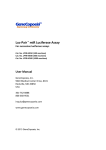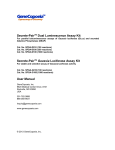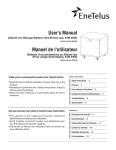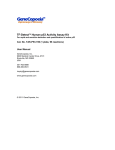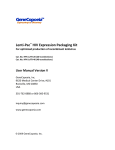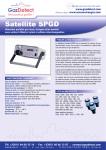Download GC npo eia eeo TM GC npo eia eeo TM
Transcript
TM G eneCopoeia Expressway to Discovery Luc-Pair ™ Duo-Luciferase Assay Kit 2.0 For luciferase assays Cat. No. LPFR-P010 (100 reactions) Cat. No. LPFR-P030 (300 reactions) Cat. No. LPFR-P100 (1000 reactions) User Manual GeneCopoeia, Inc. 9620 Medical Center Drive, #101 Rockville, MD 20850 USA 301-762-0888 866-360-9531 [email protected] www.genecopoeia.com © 2015 GeneCopoeia, Inc. Luc-Pair™ Duo-Luciferase Assay Kit 2.0 User Manual USER MANUAL Luc-Pair™ Duo-Luciferase Assay Kit 2.0 I. Introduction and Principles II. Contents and Storage III. Preparation of Cell Lysates Using Lysis Buffer IV. Preparation of FLuc and RLuc Assay Working Solution V. Procedure VI. Limited Use License and Warranty I. Introduction and Principles The study of transcriptional regulation using reporter gene expression is common and necessary in cell biology research and pharmaceutical discovery. Luciferase is the most widely used genetic reporter for gene expression studies due to several advantages, including: 1) high sensitivity in a large dynamic range 2) natural absence from mammalian cells 3) consistent reproducibility 4) cost effectiveness 5) simple assay format 6) suitable for high-throughput screening Firefly and Renilla luciferases have been widely used as co-reporters for normalization studies because both assays are quick, easy and sensitive. Firefly and Renilla luciferases are ideal co-reporters because they have distinct evolutionary origins and very different enzyme structures and substrates. This renders cross-reactivity obsolete. Firefly (Photinus pyralis) luciferase has been proven to be an ideal reporter for monitoring both promoter activity and post-transcriptional regulation in the control of gene expression. It is a cytoplasmic enzyme with a molecular weight of 61 kDa and catalyzes the following reaction: 2 Luc-Pair™ Duo-Luciferase Assay Kit 2.0 User Manual The intensity of light emission is proportional to the amount of luciferase and is measured using a luminometer or multi-function microplate reader. Renilla (Renilla reniformis) luciferase is a 36 kDa monomeric protein, which requires no post-translational processing. Therefore, it can function as a real-time transcription reporter. It catalyzes the following reaction: Using this assay system allows one to monitor the transcriptional activation of cis-elements in proximity to the gene of interest. However, it has been more difficult to measure the transcriptional repression via 3’ UTR regulation of genes since the enzymesubstrate activity window is relatively small. Longer stability of the enzyme-substrate complex allows greater flexibility in monitoring true repressive events. Further, biological variation and stochastic events may add noise, thereby reducing the differences in observed luciferase activity. Thus, normalizing the expression of an experimental reporter to the expression of an independent control reporter can help differentiate between true signal and nonspecific cellular responses. Normalization is also needed for adjusting differences in transfection efficiencies and cell viability. GeneCopoeia has leveraged the differences in firefly and Renilla enzyme structures and substrates to optimize and develop a convenient system for measuring two luciferase activities in succession. The assay measures the activities of firefly and Renilla luciferases sequentially from a single sample. The firefly luciferase luminescence is produced by one reagent, while a second reagent simultaneously quenches the firefly luciferase and produces Renilla luciferase luminescence. The GeneCopoeia Luc-Pair Luciferase Kit 2.0 development team incorporated several features into the reagents to enhance product performance and convenience, including the following: Enhanced stability. The reagents have been developed so that the signals for firefly and Renilla luciferases exhibit greater stability than the original Luc-PairTM reagents and competitor kits (Figure 1). 30 minutes after addition of the appropriate reagents at 22-25°C, firefly luciferase activity will be at least 80% of its initial activity, while Renilla luciferase activity will be at least 95% of its initial activity. Versatility. The system has been designed for use with many different eukaryotic (vertebrates, lower invertebrates,) cell lines and is optimized for use on micro-plate readers for high-throughput screening assays. Single-tube samples can also be used. Low background. The system produces very limited background luminescence. No subtraction is required from readings. Simplicity. Renilla luciferase buffer and substrate contains the quencher for firefly luciferase activity. This allows for a quick twostep assay (Figure 2). Reproducibility. This system is designed to yield reliable, linear results for a concentration range over several orders of magnitude (Figure 3). 3 Luc-Pair™ Duo-Luciferase Assay Kit 2.0 User Manual Figure 1. Stability of firefly luciferase and Renilla luciferase signals using GeneCopoeia (GCI) Luc-Pair Duo-Luciferase Assay Kit 2.0. HEK 293 cells were transfected with GeneCopoeia pEZX-MT06 miRNA reporter vector for 48 hours. A.) The FLuc and RLuc activity was measured as described in the procedure. B.)The Competitor’s dual-luciferase assay kit was used in comparison. Figure 2. Firefly luciferase activity is quenched with the addition of Buffer II. HEK 293 cells were transfected with GeneCopoeia pEZX-MT06 miRNA reporter vector for 48 hours. The firefly luciferase activity was measured as described in the procedure. Afterwards, 1x Luc Buffer II (without substrate) was added to the wells, followed by count reading in a luminometer. 4 Luc-Pair™ Duo-Luciferase Assay Kit 2.0 User Manual Figure 3. Linear relationship between emitted light and amount of luciferase expression vector transfected in HEK293. HEK 293 cells were transfected with GeneCopoeia pEZX-MT06 miRNA reporter vector for 48 hours. The FLuc (A) and RLuc (B) activities were measured in lysates from different numbers of cells after incubation for 3 min as described in the procedure. II.Contents and Storage Cat. Nos. LPFR-P010, LPFR-P030 and LPFR-P100 Quantity Contents 100 reactions 300 reactions 1000 reactions Shipping temperature Storage temperature Ice pack –20°C Stable for at least 6 months Ice pack –20°C Stable for at least 6 months Ice pack –20°C Stable for at least 6 months Ice pack –20°C Stable for at least 6 months Ice pack –20°C Stable for at least 6 months 1.0 mL Lysis Buffer (10×) Cell Lysis buffer 1.0 mL×3 10 mL 1.0 mL×2 Luc Buffer I (5×) Firefly luciferase buffer 1.0 mL×6 10 mL×2 100 µL Luc Sub I (100×) Firefly luciferase substrate 100 µL×3 500 µL×2 1.0 mL×2 Luc Buffer II (5×) Renilla luciferase buffer 1.0 mL×6 10 mL×2 100 µL Luc Sub II (100×) Renilla luciferase substrate 100 µL×3 500 µL×2 5 Luc-Pair™ Duo-Luciferase Assay Kit 2.0 User Manual III. Preparation of Cell Lysates Using Lysis Buffer The Lysis Buffer is supplied as a 10×concentrate. It may show turbid after thawing and mix which won’t affect the luciferase assays. Vortex 3-5 sec after thawing, and prepare a sufficient quantity of the 1×working concentration by adding 1 volume of 10×Lysis Buffer to 9 volumes of distilled water and mix. The diluted (1×) Lysis Buffer may be stored at -20°C for 1-2 months; however, we recommend preparing the volume of Lysis Buffer required just before use. A. Lysis of Cells Cultured in Multi-well Plates 1. Determine transfection parameters (i.e., plated cell density and subsequent incubation time) such that cells are 80-95% confluent at the desired time of lysate preparation. Remove the growth medium from the cultured cells, and gently apply a sufficient volume of phosphate buffered saline (PBS) to wash the surface of the culture vessel. Swirl the vessel briefly to remove detached cells and residual growth medium. Completely remove the rinse solution before applying Lysis Buffer. 2. Dispense into each culture well the minimum volume of 1 × Lysis Buffer required to completely cover the cell monolayer. The recommended volumes of 1×Lysis Buffer to add per well are as follows: Culture Plate 1×Lysis Buffer (μL) 6-well 500 12-well 250 24-well 100 48-well 65 96-well 20 Note: The Lysis Buffer provided in the kit is sufficient for directly lysing cells in 24-, 48- or 96-well culture plates. If a 6-well or 12-well plates are used, we recommend either purchasing more Lysis Buffer (Cat. No. LPFR-LB100) or harvesting cells by scraping or trypsinization according to the procedures in III-B below. 3. Place the culture plates on a rocking platform or orbital shaker with gentle rocking/shaking to ensure complete and even coverage of the cell monolayer with 1×Lysis Buffer. Rock the culture plates at room temperature for 10-15 minutes. Note1: If cell clumps appear, pipetting several times could be helpful to disperse the cells. Alternatively, collect the cell lysates including cell clumps in tubes and vortex 5-10 sec after cooling down on ice. Overgrown cells are more resistant to complete lysis, and typically require an increased volume of lysis buffer to ensure complete lysis. Note2: The firefly and Renilla luciferases contained in the cell lysates are stable for at least 30minutes at room temperature (22°C) and up to 2 hours on ice. –70°C is recommended for long-term storage. Subjecting cell lysates to more than 3 freezethaw cycles may result in gradual loss of luciferase reporter enzyme activities. 4. Transfer the lysate to a tube or vial for further handling and storage. Alternatively, reporter assays may be performed directly in the 96-well culture plate if the plates are compatible with the type of luminometer being used. 6 Luc-Pair™ Duo-Luciferase Assay Kit 2.0 User Manual B. Lysis of Cells in tubes. 5. For cells cultured in suspension, or cells harvested by scraping or trypsinization. Collect 1-2×105 cells in 1.5mL tubes, rinse cells with 1mL of PBS buffer, spin at 500g for 5minutes, and completely remove the rinse solution. 6. Add 50-100uL of 1 × Lysis Buffer to make 2 × 103 cells/μL, stand on ice for 2-5 min, vortex 5-10 seconds to completely lyse the cells. Note: The firefly and Renilla luciferases contained in the cell lysates are stable for at least 30minutes at room temperature (22°C) and up to 2 hours on ice. –70°C is recommended for long-term storage. Subjecting cell lysates to more than 3 freezethaw cycles may result in gradual loss of luciferase reporter enzyme activities. 7. Proceed to Luciferase assay. IV. Preparation of FLuc and RLuc Assay Working Solution Note 1. Luc Buffers I and II are stable at –20°C for at least 6 months. Freezing and thawing the reagents3-4 cycles won’t affect the activity of the luciferases. Aliquotting is recommended if more freeze-thaw cycles are required. Note 2.Working Solutions (Buffers contain Substrates) are stable at room temperature for 1-2 hours. Prepare only the required amount of Working Solution before use. Note 3. Light intensity is a measure of the rate of catalysis by the luciferases, and is therefore, temperature sensitive. The temperature optimum for the activity of both luciferases is approximately room temperature (20–25°C), so it is important that the reagents be equilibrated to room temperature before beginning measurements. 1. Thaw Luc Buffer I (5×) and Luc Buffer II vortexing for 3-5 seconds. (5×) thoroughly at room temperature, inverting the tube several times and then Note: Some pellets may appear in the Luc Buffer II (5×) after thawing. It is important to completely dissolve the pellets before using. Incubation at 37°C for 5-10 minutes and more vortexing will be necessary to fully re-dissolve the pellets. 2. Dilute 1:5 in distilled water to make 1×Luc Buffer I and 1×Luc Buffer II. Prepare 100 µL of each Buffer for each reaction (well). Duplicates or triplicates for each sample are recommended. Example: If you have 5 samples in duplicated reactions, prepare 1 mL of 1×Luc Buffer I and 1×Luc Buffer II. by diluting 0.2mL of each 5×Buffers with 0.8 mL ddH2O respectively. Preparing a little extra may be helpful to avoid buffer shortage caused by pipetting error. 3. Prepare the FLuc and RLuc Assay Working Solution (e.g.10 samples) by adding 10 μL of Luc Sub I and II (100×) to 1 mL of 1×Luc Buffer I and 1×Luc Buffer II, respectively. Mix well by inverting the tube several times. 4. Incubate at room temperature for 5 minutes (capped and protected from light) before adding to the samples. Note: The RLuc Assay Working Solution will be used after reading the FLuc assay. It can be kept at room temperature as long as 1 hour if properly capped and protected from light. 7 Luc-Pair™ Duo-Luciferase Assay Kit 2.0 User Manual V. Assay Procedure 1. Set up the luminometer. Follow the manual associated with your plate reader. Set the measurement for 1-2 seconds of integration. 2. Pipette the cell lysis samples (20 μL per well) into a 96-well white (opaque) or black plate, or luminometer tubes. 3. Add the FLuc Assay Working Solution from step IV-4 (100 μL per well or tube) to the samples. Gently pipette up and down mix the sample and assay solution. Do not vortex. Note: If you have many samples and use 96-well plates, we recommend using a multi-channel pipette in order to reduce the time between additions of Assay Working Solution to each well. Auto-Injector is not recommended for this kit. 4. Incubate at room temperature for 3-5 minutes and proceed with the measurement. Note: Read the plate(s) within 5 minutes after the incubation. If using single luminometer tubes, make sure the incubation and processing times before the luminescence detection are identical for all samples. 5. Save the reading if the luminometer reader does not automatically record the readings. 6. Remove the plates or luminometer tubes. 7. Add the RLuc Working Solution from Step IV-4 (100 μL per well or tube) to the plates or tubes from Step V-6. Gently pipette up and down or tap the plate (tube) several times to mix the sample and assay solution. Do not vortex. Note: If you have many samples and use 96-well plates, we recommend using a multi-channel pipette in order to reduce the time between additions of Assay Working Solution to each well. Auto-Injector: is not recommended for this kit. 8. Incubate at room temperature for 3-5 minutes and proceed with the measurement. Note: Read the plate(s) within 5 minutes after the incubation. If using single luminometer tubes, make sure the incubation and processing times before the luminescence detection are identical for all samples. 9. Record the reading if the luminometer reader does not automatically save the readings. 10. Remove the plates or luminometer tubes. 11. Calculate the ratio of luminescence from the firefly luciferase to the Renilla luciferase. IMPORTANT NOTE: Because the luminescent signals are affected by assay conditions, raw results should be compared only between samples measured at the same time and using the same medium/serum combination. Incorporation of consistent control wells on each plate provides the ability to calculate a normalized firefly luminescence/Renilla luminescence ratio for each sample well. These normalized ratios will remain essentially constant (±10%) for samples in a plate measured during the 1-hour measurement window. 8 Luc-Pair™ Duo-Luciferase Assay Kit 2.0 User Manual VII. Limited Use License and Warranty Limited Use License Following terms and conditions apply to use of the Luc-Pair™ Duo-Luciferase Assay Kit 2.0 (the Product). If the terms and conditions are not acceptable, the Product in its entirety must be returned to GeneCopoeia within 5 calendar days. A limited End-User license is granted to the purchaser of the Product. The Product shall be used by the purchaser for internal research purposes only. The Product is expressly not designed, intended, or warranted for use in humans or for therapeutic or diagnostic use. The Product must not be resold, repackaged or modified for resale, or used to manufacture commercial products or deliver information obtained in service without prior written consent from GeneCopoeia. This Product should be used in accordance with the NIH guidelines developed for recombinant DNA and genetic research. Use of any part of the Product constitutes acceptance of the above terms. Limited Warranty GeneCopoeia warrants that the Product meets the specifications described in the accompanying Product Datasheet. If it is proven to the satisfaction of GeneCopoeia that the Product fails to meet these specifications, GeneCopoeia will replace the Product. In the event a replacement cannot be provided, GeneCopoeia will provide the purchaser with a refund. This limited warranty shall not extend to anyone other than the original purchaser of the Product. Notice of nonconforming products must be made to GeneCopoeia within 30 days of receipt of the Product. GeneCopoeia’s liability is expressly limited to replacement of Product or a refund limited to the actual purchase price. GeneCopoeia’s liability does not extend to any damages arising from use or improper use of the Product, or losses associated with the use of additional materials or reagents. This limited warranty is the sole and exclusive warranty. GeneCopoeia does not provide any other warranties of any kind, expressed or implied, including the merchantability or fitness of the Product for a particular purpose. GeneCopoeia is committed to providing our customers with high-quality products. If you should have any questions orconcerns about any GeneCopoeia products, please contact us at 301-762-0888. © 2015 GeneCopoeia, Inc. GeneCopoeia Products are for Research Use Only Trademarks: GeneCopoeia ™, Luc-Pair™, and (GeneCopoeia Inc). Copyright © 2015 GeneCopoeia Inc. UMLPRFM002-021815 9









